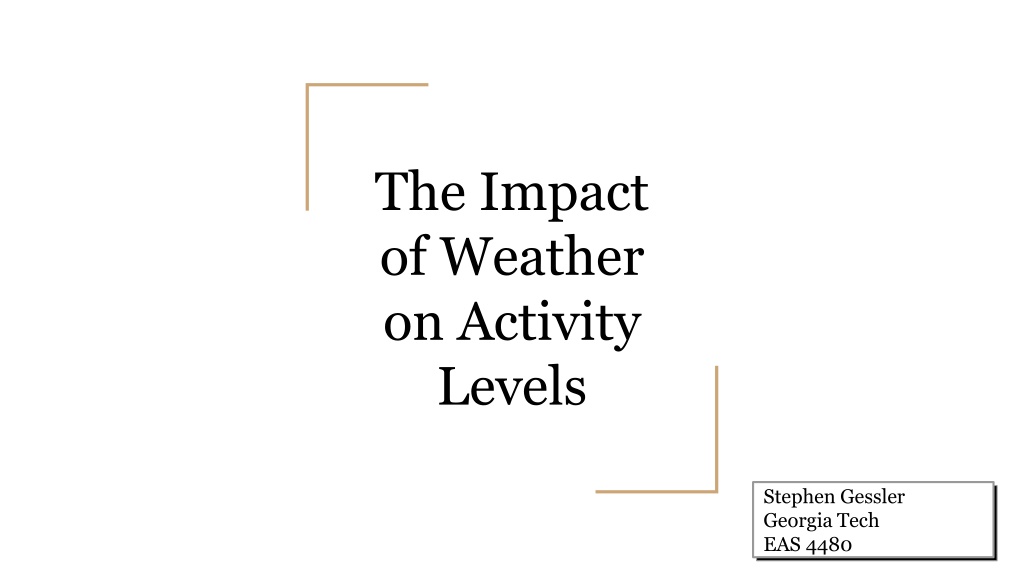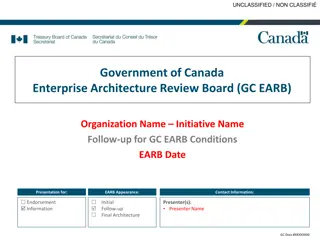
Impact of Weather on Activity Levels: Research Insights
Explore the correlation between weather conditions and activity levels in this study conducted at Georgia Tech. Discover how factors like precipitation and temperature affect urban planning and fitness motivation. Dive into related research findings and scientific hypotheses, providing valuable insights into the influence of weather on physical activity.
Download Presentation

Please find below an Image/Link to download the presentation.
The content on the website is provided AS IS for your information and personal use only. It may not be sold, licensed, or shared on other websites without obtaining consent from the author. Download presentation by click this link. If you encounter any issues during the download, it is possible that the publisher has removed the file from their server.
E N D
Presentation Transcript
The Impact of Weather on Activity Levels Stephen Gessler Georgia Tech Stephen Gessler Georgia Tech EAS 4480 EAS 4480
Motivation for this study: Active lifestyle is stress management technique. Activity levels decrease in the winter. High levels of depression/suicide in the winter. (SAD) Assist urban planning in making cities more fitness friendly regardless of weather.
Related Research Correlation of low activity levels in areas with hot, humid weather. Baranowski 1993 Winter season in temperate climate is correlated to lower activity levels. Dannenberg 1989 Inactivity levels in Canada jump from 49% in the Summer to 64% in Winter. Merchant 2007
Scientific Problem How does quality of weather influence activity levels? Null Hypothesis There is no correlation between poor weather and activity levels. Gym memberships aren t reserved for rainy days Activity level = Gym Attendance
Introduction to Project Data Source: Snap Fitness in Inman Park Sample Size 600 active members Electronic attendance system (April 2016 - March 2017) Evaluate dependence of attendance on weather (NOAA.gov NCDC CDO) Precipitation High Temperature Low Temperature
CI [177.79 31.98] CI [176.88 55.38]
CI [174.66 34.47] CI [178.98 50.58]
CI [177.99 32.39] CI [176.87 54.83]
CI [196.47 37.44] CI [196.45 57.26]
Correlation Values Warm Months Cold Months Max Temp -0.1027 0.0058 Min Temp -0.0699 0.0577 Avg Temp -0.1013 0.0119 Precip 0.1152 0.0460
Coherence - Entire data set for comparison
Conclusion Correlation between weather and gym attendance data is not clear with these parameters. Hot months/cold months not a significant way to distribute data. Need more analysis with continuous weather data. Daily Max/Min/Precip does not provide comprehensive depiction of weather influences. (i.e. Precip could occur at night.) Weather could have no impact on gym behavior. (NO EXCUSES ) Nice weather days may result in people exercising outside.
Sources: Baranowski T, Thompson WO, DuRant RH, Baranowski J, Puhl J. Observations on physical activity in physical locations: age, gender, ethnicity, and month effects. Res. Q. Exerc. Sport. 1993;64:127 Dannenberg AL, Keller JB, Wilson PWF, Castelli WP. Leisure time physical activity in the Framingham Offspring Study: Description, seasonal variation, and risk factor correlates. Am. J. Epidemiol. 1989;129:76 88. Merchant AT, Dehghan M, Akhtar-Danesh N. Seasonal variation in leisure-time physical activity among Canadians. Can. J. Public Health. 2007;98:203 208. Chan CB, Ryan DA. Assessing the Effects of Weather Conditions on Physical Activity Participation Using Objective Measures. Int. J. of Env. Res. and Pub. Health. 2009;6(10):2639-2654.






















